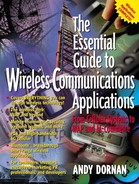Cordless Telephony
A cordless phone, as opposed to a mobile, works only with one specific base station and uses unlicensed spectrum. The base station is known as a fixed point because it is connected to the regular fixed phone network. Transmission power is very low, for a range of 100 m or less.
Cordless phones are usually sold for home use in sets of a single phone and base station that can cost under $50. More sophisticated systems are available for businesses, which sell several handsets that all work with the same base station. The base station often incorporates a miniature PBX (Private Branch Exchange), so that users can dial each other privately as well as make external calls.
Because cordless phones compete heavily on price, many use the simplest possible technology: analog FM in the ISM band. This results in terrible, often incomprehensible, voice quality. Even when a user is standing next to their fixed point, interference can make a cordless call sound worse than a GSM where the phone and base station are separated by several miles.
To overcome this problem, an increasing number of users are turning to digital cordless systems. These offer voice quality as good as the fixed network, and sometimes even high-speed data. Echoing the situation with HiperLan, Europe and Japan both have government-mandated standards using specific spectrum, while the U.S. allows any system to be used, provided that it meets safety requirements.
Telepoint
The theory behind telepoint systems was that they allowed the same phone to be used in both private and public networks. Telepoint operators set up hundreds of cordless fixed points around cities, often in areas such as shopping malls and subway stations, which were originally difficult for true mobile systems to reach.
Telepoint's fatal flaw was that it could only be used to make calls, not receive them. Consumers couldn't see any benefits over a regular phone box and perceived it as "poor man's mobile." It was never tried in the U.S., and many European networks failed. An ETSI standard known as CT-2 (Cordless Telephone System 2) was eventually abandoned.
Some Telepoint networks did enjoy success in Asia, primarily because they were used for services other than telephony. Japan's system incorporated its own store-and-forward messaging service, and eventually allowed people to dial up to an ISP and surf the Web or check email.
Standards
Most American digital cordless systems use proprietary spread spectrum technologies, in one of the ISM bands. Europe and Japan have both defined standards, known respectively as DECT (Digital Enhanced Cordless Telephony) and PHS (Personal Handyphone System).
The standards are very similar. Both use TDD and TDMA, and offer a data rate of 64 kbps one way (or 32 kbps each way). This results in very clear voice quality and is close to ISDN-speed Internet access. But they have been put to different applications. DECT is still used almost entirely for private cordless systems, while PHS was the basis of a very popular telepoint network.
Table 9.4 compares the technical details of the two systems. Because they employ TDD instead of paired spectrum, the maximum number of users is only half the number of TDMA slots; each needs at least two slots, one to transmit and one to receive.
| PHS | DECT | |
|---|---|---|
| Spectrum | 1895–1918 MHz | 1880–1900 MHz |
| Modulation | QPSK | GMSK |
| Channel bandwidth | 300 kHz | 2 MHz |
| Gross data rate per channel | 384 kbps | 1152 kbps |
| Usable data throughput per channel | 128 kbps | 768 kbps |
| TDMA slots per channel | 4 | 24 |
| Maximum users per channel | 2 | 12 |
| Available in | Japan | Europe |
Picocells
Some companies are pushing private base stations based on one of the public cellular standards, usually GSM. These should allow people to use the same phone wherever they are, both to make and receive calls. If a cell were placed in the home or office, calls could be routed over the fixed rather than the mobile network, theoretically saving money.
So far, few companies and almost no homes have actually deployed these systems, called picocells. But vendors have high hopes. They forecast particular popularity in the U.S., where GSM coverage is poor and big radio-blocking skyscrapers are common. The FCC has even allocated an unlicensed PCS spectrum band, meaning that anyone can set up a low-power system. In other countries, they require cooperation from a cellular operator because cellular frequencies have usually been licensed to the operator.
Picocells can be connected to the outside world in two ways, both of which are illustrated in Figure 9.6.
Via the public telephone system. This makes the network truly private, under the full control of whoever set up the base station. It can be the easiest type to set up, but means that advanced mobile services, such as SMS, are not available. People dialing the mobile number may also fail to get through, unless the mobile is still within range of a public base station.
Via the mobile network. Some operators and companies collaborate on setting up picocells so that they can also be used by other subscribers to the mobile network. This would seem to be the best solution for everyone, as costs are shared and the network extended, but it does mean that capacity is not dedicated to the company in whose office the fixed point is placed.
Figure 9.6. GSM picocell within a building

